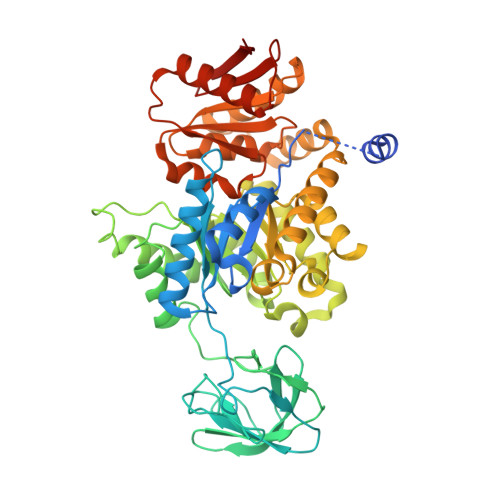Crystal structure of Cryptosporidium parvum pyruvate kinase.
Cook, W.J., Senkovich, O., Aleem, K., Chattopadhyay, D.(2012) PLoS One 7: e46875-e46875
- PubMed: 23056503
- DOI: https://doi.org/10.1371/journal.pone.0046875
- Primary Citation of Related Structures:
4DRS - PubMed Abstract:
Pyruvate kinase plays a critical role in cellular metabolism of glucose by serving as a major regulator of glycolysis. This tetrameric enzyme is allosterically regulated by different effector molecules, mainly phosphosugars. In response to binding of effector molecules and substrates, significant structural changes have been identified in various pyruvate kinase structures. Pyruvate kinase of Cryptosporidium parvum is exceptional among known enzymes of protozoan origin in that it exhibits no allosteric property in the presence of commonly known effector molecules. The crystal structure of pyruvate kinase from C. parvum has been solved by molecular replacement techniques and refined to 2.5 Å resolution. In the active site a glycerol molecule is located near the γ-phosphate site of ATP, and the protein structure displays a partially closed active site. However, unlike other structures where the active site is closed, the α6' helix in C. parvum pyruvate kinase unwinds and assumes an extended conformation. In the crystal structure a sulfate ion is found at a site that is occupied by a phosphate of the effector molecule in many pyruvate kinase structures. A new feature of the C. parvum pyruvate kinase structure is the presence of a disulfide bond cross-linking the two monomers in the asymmetric unit. The disulfide bond is formed between cysteine residue 26 in the short N-helix of one monomer with cysteine residue 312 in a long helix (residues 303-320) of the second monomer at the interface of these monomers. Both cysteine residues are unique to C. parvum, and the disulfide bond remained intact in a reduced environment. However, the significance of this bond, if any, remains unknown at this time.
Organizational Affiliation:
Department of Pathology, University of Alabama at Birmingham, Birmingham, Alabama, United States of America.

















